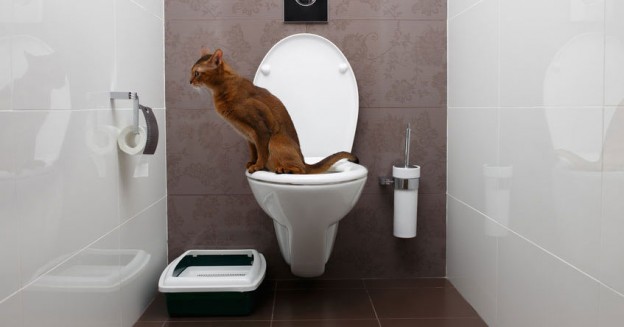The Risks of Flushing Cat Poop in Your Toilet - Preventive Steps
The Risks of Flushing Cat Poop in Your Toilet - Preventive Steps
Blog Article
Just how do you feel with regards to How to Dispose of Cat Poop and Litter Without Plastic Bags?

Introduction
As pet cat owners, it's important to be mindful of exactly how we dispose of our feline close friends' waste. While it might appear convenient to purge feline poop down the commode, this method can have detrimental repercussions for both the environment and human health and wellness.
Alternatives to Flushing
The good news is, there are much safer and much more accountable ways to dispose of cat poop. Consider the complying with choices:
1. Scoop and Dispose in Trash
The most common approach of getting rid of cat poop is to scoop it into a biodegradable bag and toss it in the garbage. Make sure to make use of a dedicated clutter scoop and throw away the waste without delay.
2. Usage Biodegradable Litter
Opt for biodegradable feline litter made from materials such as corn or wheat. These trashes are eco-friendly and can be safely dealt with in the trash.
3. Bury in the Yard
If you have a yard, take into consideration hiding pet cat waste in a marked area away from vegetable gardens and water sources. Be sure to dig deep sufficient to stop contamination of groundwater.
4. Set Up a Pet Waste Disposal System
Purchase an animal waste disposal system particularly developed for pet cat waste. These systems make use of enzymes to break down the waste, minimizing odor and ecological influence.
Wellness Risks
Along with environmental concerns, flushing pet cat waste can also pose health and wellness risks to human beings. Feline feces might include Toxoplasma gondii, a parasite that can create toxoplasmosis-- a potentially extreme health problem, particularly for expectant females and individuals with damaged immune systems.
Ecological Impact
Purging feline poop introduces damaging microorganisms and bloodsuckers right into the water system, positioning a substantial threat to aquatic ecological communities. These impurities can negatively impact aquatic life and concession water quality.
Verdict
Accountable animal ownership extends beyond supplying food and shelter-- it also entails proper waste monitoring. By avoiding purging feline poop down the commode and choosing different disposal approaches, we can minimize our ecological impact and protect human health and wellness.
Why Can’t I Flush Cat Poop?
It Spreads a Parasite
Cats are frequently infected with a parasite called toxoplasma gondii. The parasite causes an infection called toxoplasmosis. It is usually harmless to cats. The parasite only uses cat poop as a host for its eggs. Otherwise, the cat’s immune system usually keeps the infection at low enough levels to maintain its own health. But it does not stop the develop of eggs. These eggs are tiny and surprisingly tough. They may survive for a year before they begin to grow. But that’s the problem.
Our wastewater system is not designed to deal with toxoplasmosis eggs. Instead, most eggs will flush from your toilet into sewers and wastewater management plants. After the sewage is treated for many other harmful things in it, it is typically released into local rivers, lakes, or oceans. Here, the toxoplasmosis eggs can find new hosts, including starfish, crabs, otters, and many other wildlife. For many, this is a significant risk to their health. Toxoplasmosis can also end up infecting water sources that are important for agriculture, which means our deer, pigs, and sheep can get infected too.
Is There Risk to Humans?
There can be a risk to human life from flushing cat poop down the toilet. If you do so, the parasites from your cat’s poop can end up in shellfish, game animals, or livestock. If this meat is then served raw or undercooked, the people who eat it can get sick.
In fact, according to the CDC, 40 million people in the United States are infected with toxoplasma gondii. They get it from exposure to infected seafood, or from some kind of cat poop contamination, like drinking from a stream that is contaminated or touching anything that has come into contact with cat poop. That includes just cleaning a cat litter box.
Most people who get infected with these parasites will not develop any symptoms. However, for pregnant women or for those with compromised immune systems, the parasite can cause severe health problems.
How to Handle Cat Poop
The best way to handle cat poop is actually to clean the box more often. The eggs that the parasite sheds will not become active until one to five days after the cat poops. That means that if you clean daily, you’re much less likely to come into direct contact with infectious eggs.
That said, always dispose of cat poop in the garbage and not down the toilet. Wash your hands before and after you clean the litter box, and bring the bag of poop right outside to your garbage bins.
https://trenchlesssolutionsusa.com/why-cant-i-flush-cat-poop/

I ran across that blog entry about Can You Flush Cat Poo or Litter Down the Toilet? while perusing the internet. Are you aware of somebody who is in the market for the niche? Feel free to promote it. I praise you for your time. Visit us again soon.
Visit My Website Report this page